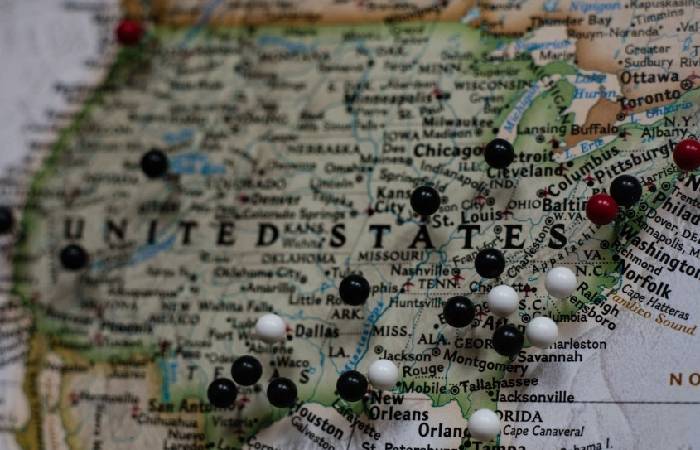Largest Countries in the World – the world is made up of many countries of varying sizes. Some countries are small, and some are huge. The ten most prominent countries in the world listed by total area are Russia, Canada, China, the United States, Brazil, Australia, India, Argentina, Kazakhstan and Algeria. These countries cover more than 55% of the land area and occupy most of the Earth’s surface. Of these countries, Russia is the largest, accounting for about 11% of the Earth’s total area.
Interestingly, many of the world’s great powers are in the northern hemisphere. Countries in the northern hemisphere tend to be larger because of their geography, climate, and history. For example, Russia and Canada are located in the Far North, and their vast tracts of land and harsh climates keep their populations relatively low. China, India and the United States are all the largest countries in the world with large populations and also belong to the Northern Hemisphere. We are showing the largest countries in the world.
5 Largest Countries in the World

Russia
Russia is by far the largest country on Earth. It’s more than twice her size in Brazil (the fifth largest country in the world). Russia occupies a tenth of the Earth’s land mass, occupies two different continents, spans 11 time zones, and borders 14 countries.
Surrounded by her three seas – the Atlantic, Pacific and Arctic – Russia has about 100,000 rivers and Lake Baikal, the oldest and deepest lake in the world. The landscape is very diverse, from deserts to mountains to vast deciduous forests. Most of Russia covers with treeless grasslands called steppe and taiga, or northern coniferous forests. Russia is also home to unique animals such as snow leopards, polar bears, arctic foxes, Siberian tigers, bighorn sheep and Russia’s national animal, the Eurasian brown bear.
Canada
Canada is the other largest nation in the world, occupying more than half of the northern hemisphere. Its northern edge is the Arctic Ocean, and its southern border is with the United States. Also, from east to west, Canada covers 4,700 miles (7,560 kilometers) of North America spanning six time zones from the Atlantic to the Pacific.
Canada is a very remote country. Despite being a vast country, only 0.5 per cent of the world’s population lives in her. And it leaves plenty of wildlife, such as beavers, elk, polar bears, bison, killer whales, caribou and grizzly bears. Canada is known for its coastal waters and territorial waters. Its lakes and rivers contain 20% of the world’s freshwater supply and have the longest coastline in the world. Inland are the majestic Rocky Mountains, vast boreal forests, tundra, rolling plains and the Canadian Shield, a hilly wetland where scientists have discovered the world’s oldest geological formations.
United States
The United States is her third largest country, but its landmasses are not contiguous. Of her 50 states in the North American continent, only her 48 connect, bordering Canada to the north and Mexico to the south. One-fifth of the area is in Alaska, which is not connected to the rest of the state but extends west of Canada. Hawaii, another noncontiguous (albeit very small) form, is located in the middle of the Pacific Ocean, about 2,000 miles (3,200 kilometres) from the mainland United States.
Also, due to its size and the fact that not all states are interconnected, the United States has examples of all kinds of climates in the world. The tropical regions of Hawaii and Florida, the deserts of the Southwest, the polar regions of Alaska, and the arctic temperatures of the western Rocky Mountains are just a few examples.
China
Because China is so large and close to the United States and Canada, her close range with her two monsters in North America is debatable among some geographers. China is technically the fourth-largest country in the world, as it has far less coastline than its three other significant powers and includes a portion of the continental shelf that juts out into the sea as a territory. On the other hand, if we measure only the surface area of each country, China is the second largest, followed by the United States and Canada.
China borders 14 countries and spans five geographic time zones, but the country uses only one standard time for her, called Beijing time. China has a little bit of everything. Forest. Deserts, grasslands, high and dry plateaus. Wet coasts and thousands of rivers, including the Yangtze River, the third longest in the world. One-third of China’s land mass covers the mountains, and on the border of China and Nepal is Mount Everest, the highest mountain in the world.
Brazil
Brazil is the leading country in South America and the fifth largest country in the world. Shaped like a giant wedge, it borders 10 of her 12 countries on the continent. Brazil is home to the Amazon, the world’s largest river by volume, whose basin stretches thousands of kilometres across the northern part of the country. Brazil is famous for the Amazon and its rainforests. Still, the government has 7,400 kilometres of coastline along the Atlantic Ocean, with pine forests, marshes, plateaus, and arid grasslands called pampas.




GIPHY App Key not set. Please check settings